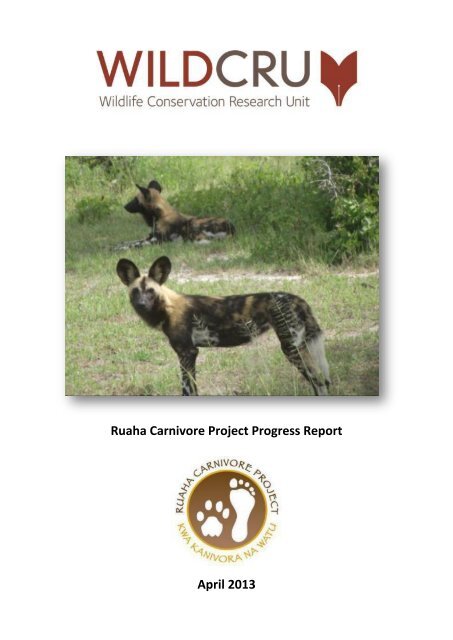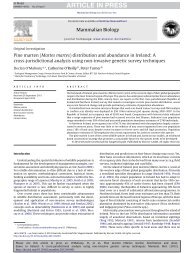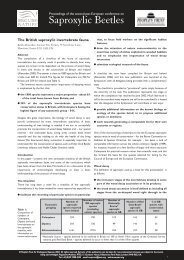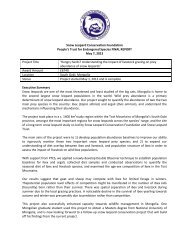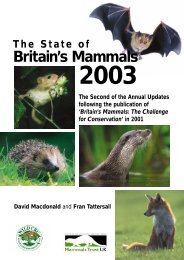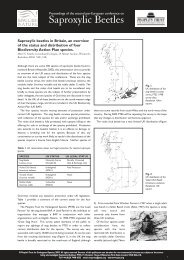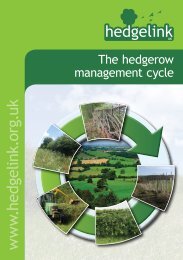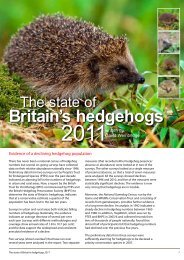full report - Saving Big Cats and Wild Dogs
full report - Saving Big Cats and Wild Dogs
full report - Saving Big Cats and Wild Dogs
Create successful ePaper yourself
Turn your PDF publications into a flip-book with our unique Google optimized e-Paper software.
Ruaha Carnivore Project Progress ReportApril 2013
Dear friends of the Ruaha Carnivore Project,The second half of 2012 <strong>and</strong> first part of 2013 have exceeded even our ownexpectations. The Lion Guardians programme got off to a very quick <strong>and</strong> so farsuccessful start, with three staff members <strong>and</strong> five Barabaig Lion Guardians hired.We had the entire dry season, when the number of depredations is low, to getthem used to their jobs <strong>and</strong> the Barabaig community used to the idea of not killinglions. They then proved their worth in this recent rainy season, as they helped stopnumerous lion hunts, <strong>and</strong> helped reduce lion killing in the core study area.We had hoped to provide two <strong>full</strong> secondary school scholarships to pastoralistchildren. Instead, we raised enough money to send six children to secondary school,which was really great.Thanks to grants from the National Geographic <strong>Big</strong> <strong>Cats</strong> Initiative <strong>and</strong> othersupporters, we have now predator-proofed over 50 livestock enclosures, which isgreat. No livestock have been killed in the improved enclosures, which has reducedthe local economic costs of carnivore presence <strong>and</strong> the need for retaliatory killing.Our camp has grown tremendously: we have added two b<strong>and</strong>as (thatch-roofedplatforms to protect our tents from the elements <strong>and</strong> marauding wildlife), areslowly replacing our nylon tents with second-h<strong>and</strong> canvas ones (that hope<strong>full</strong>y willbe less inviting to snakes <strong>and</strong> mice), have exp<strong>and</strong>ed our solar power array, <strong>and</strong>—most exciting of all—have run a water pipe from Kitisi to camp! This wassurprisingly inexpensive <strong>and</strong> saves many hours of manpower <strong>and</strong> wear <strong>and</strong> tear onour vehicles.You can read more about what we are doing below <strong>and</strong> also find out more on ourwebsite www.ruahacarnivoreproject.com or on Facebook. None of our work wouldbe possible without all of our supporters, so huge thanks from the entire team foreverything you are doing. We hope that you enjoy the <strong>report</strong>!Best wishes, the RCP teamDr. Amy Dickman, director; Dr. Maurus Msuha, scientific collaborator; MontyKalyahe, senior research assistant; Ayubu Msago, community liaison; MsafiriMgumba, senior research assistant; Justin Chumbulila, research assistant;Stephano Asecheka, Lion Guardians coordinator; <strong>and</strong> George Sedoyeka, LionGuardians coordinator.Cover photo by Mdonya Old River Lodge’s game driver, Kahimba.Page 1
Ruaha Carnivore Project Progress Report – March 2013ABOUT THE RUAHA LANDSCAPE AND THE RUAHA CARNIVORE PROJECTTanzania’s Ruaha l<strong>and</strong>scape, which includes the Ruaha National Park, <strong>Wild</strong>life ManagementAreas, Game Reserves <strong>and</strong> neighbouring village l<strong>and</strong>s, is one of the most important places inthe world for large carnivores: this area holds over 10% of the world’s remaining lions, oneof only four cheetah populations in East Africa numbering 200 individuals or more, the thirdlargest population of endangered African wild dogs in the world, <strong>and</strong> globally importantpopulations of leopards <strong>and</strong> spotted hyaenas. However, despite its significance, very littlescientific research has been conducted on Ruaha’s carnivores, hindering the development ofeffective conservation plans. Furthermore, there is intense human-carnivore conflict in thelocal area, which is a major conservation issue. This conflict – in which carnivores pose athreat to people or their stock, <strong>and</strong> people respond by killing carnivores – causes severeproblems for both villagers <strong>and</strong> carnivores, so reducing it is a top priority for the project.The Ruaha Carnivore Project, which was established in 2009, is part of the <strong>Wild</strong>lifeConservation Research Unit (<strong>Wild</strong>CRU) within Oxford University’s Zoology Department. Itworks in partnership with Tanzanian organisations such as the Tanzanian <strong>Wild</strong>life ResearchInstitute (TAWIRI) <strong>and</strong> National Parks authorities to achieve the following:(i) Provide baseline information on large carnivore distribution, relative abundance <strong>and</strong>ecology across the Ruaha l<strong>and</strong>scape, including both protected <strong>and</strong> unprotected l<strong>and</strong>; <strong>and</strong>(ii) Reduce the costs <strong>and</strong> improve the benefits associated with living alongside carnivores forlocal people, thereby reducing human-carnivore conflict in this critically important area.Page 2
Ruaha Carnivore Project Progress Report – April 2013GENERAL NEWSFive Barabaig Warriors become the first Ruaha Lion GuardiansThanks to a grant from Panthera, <strong>and</strong> through close partnership with the Lion Guardiansorganisation in Kenya, five young Barabaig warriors have been hired as RCP’s first LionGuardians. As Lion Guardians, the warriors help protect lions in human-dominated areas bycollecting data on lions, warning people of lions’ presence in grazing areas, helping villagersrepair livestock enclosures, locating lost livestock (<strong>and</strong> children) <strong>and</strong> working with otherwarriors in the community to prevent lion hunts.The Barabaig are responsible for the majority of the Ruaha area’s lion killings, both inretaliation for livestock depredation <strong>and</strong> as part of their coming-of-age rituals. They are anintensely secretive group who typically do not mix with outsiders, <strong>and</strong> earning their trusttook RCP staff almost two years. But since agreeing to become part of the Lion Guardiansprogramme, which originated in Kenya with the Maasai, there has been a striking decline inlion killings in the core study area. This is particularly impressive as convincing a Barabaigwarrior to renounce lion killing is no small feat — some of the Barabaig Lion Guardians<strong>report</strong>ed participating in more than 90 lion hunts before becoming Guardians!Our Lion Guardians team (from left to right): Gwagi Gaga, Daremu Philipo, StephanoAsecheka (ccordinator), Ema Kwashema, M<strong>and</strong>ela Dudmeka <strong>and</strong> Daudi KinyokaThe Barabaig’s commitment was sorely tested in February, when almost nightly attacks onBarabaig bomas caused more than a dozen livestock deaths. The Lion Guardians <strong>and</strong> RCPstaff worked day <strong>and</strong> night — even staying at vulnerable bomas overnight — to help preventattacks <strong>and</strong> retaliatory lion hunts. The Lion Guardians intercepted one hunt <strong>and</strong> convincedthe warriors to turn back, <strong>and</strong> eventually the attacks stopped without any lions being killed.We look forward to <strong>report</strong>ing on more successes as the programme grows.Page 3
Ruaha Carnivore Project Progress Report – April 2013First Simba Scholars start school!One of the benefits that local villagers said they would most appreciate from the presenceof carnivores was better access to education. To address this, in 2012 RCP raised funds,through the AZA Conservation Endowment Fund <strong>and</strong> private donors, to provide six ‘SimbaScholarships’. These are competitive scholarships available for children from local pastoralistfamilies, <strong>and</strong> the six Scholars began attending Idodi Secondary School in February 2013. It ishard for villagers to pay for their children to attend secondary school, so this has been veryimportant in terms of a tangible benefit to local people, as it will have long-term value forthe students <strong>and</strong> their families. To learn more about these first Simba Scholars, visit ourwebsite at www.ruahacarnivoreproject.com. Please contact RCP if you are interested inlearning more about the Scholarships or funding a Simba Scholar next year.Ayubu Msago (RCP’s community liaison) with the six Simba Scholars: from left to right, GraceNchachi, Herieth Charles, John Kunguti, Kwangu Charles, Isaya Koyesa, & Zawadiana DanielStaff UpdatesMsafiri Mgumba has returned to camp after completing his Postgraduate Diploma inInternational <strong>Wild</strong>life Conservation Practice at Oxford University. We are thrilled to havehim back with all his new skills, <strong>and</strong> have promoted him to Senior Research Assistant.Research Assistant Meshack Saigulu received a scholarship to undertake his Masters degreeat the Nelson M<strong>and</strong>ela African Institute of Science <strong>and</strong> Technology (NM-AIST) – we are sadnot to have him at camp but will be working with him again both during <strong>and</strong> after hisdegree. Stephano Asecheka <strong>and</strong> George Sedoyeka came on board to manage the LionGuardians programme, <strong>and</strong> Justin Chambulila has been hired as a research assistant for RCP.Page 4
Ruaha Carnivore Project Progress Report – April 2013New options for donatingPeople interested in giving to the Ruaha Carnivore Project - in particular those in the UnitedStates - have a great new option for online donations. The Houston Zoo is hosting adonation page for lion conservation organizations, <strong>and</strong> RCP is one of the featuredorganizations. To check out our gorgeous <strong>and</strong> easy-to-use page, go towww.houstonzoo.org/lionssp/projects/ruaha-carnivore-project. Please give! U.S. tax-payers<strong>and</strong> others can also make tax-free donations through Americans for Oxford atwww.oxfordna.org/giving_how.htm. Remember to designate the Ruaha Carnivore Project asthe recipient of your donation. One hundred percent of your donations, through either link,go directly to support RCP’s research <strong>and</strong> programmes that help people living in the Ruahal<strong>and</strong>scape better coexist with carnivores.Do you want to get involved with exploring wild Africa, from the comfort of your ownhome? Now you can, through RCP’s newest initiative, the Ruaha Explorer’s Club (REC). RECmembers become virtual explorers of the Ruaha l<strong>and</strong>scape by sponsoring one of our cameratraps that move throughout this relatively uncharted area. Each camera’s images <strong>and</strong> GPScoordinates are posted on designated Facebook pages that the sponsors control, givingExplorers a unique insight into the work of RCP <strong>and</strong> the wonders of Ruaha’s wildlife. Thefirst sponsorships are being trialled <strong>and</strong> the programme will be made public in the spring of2013. Look for news on this fun initiative on our website (www.ruahacarnivoreproject.com)<strong>and</strong> Facebook page: http://www.facebook.com/pages/Ruaha-Carnivore-Project/116298238442772.Page 5
Ruaha Carnivore Project Progress Report – April 2013RESEARCHING CARNIVORE ECOLOGYDespite the global significance of the Ruaha l<strong>and</strong>scape, very little research has beenconducted to date; thus remarkably little is known about the number, distribution orecology of its valuable carnivore populations. We are working with a variety of stakeholders,including Tanzanian authorities, Park lodges <strong>and</strong> tourists to collect as much reliable data aspossible on Ruaha’s carnivore populations. These data are then shared with organisationssuch as TAWIRI, where we hope they will assist in the development of conservation <strong>and</strong>management plans for carnivores in the Ruaha l<strong>and</strong>scape.Camera-trappingRCP staff continue to analyse the data in the images recorded in our camera traps. To date,we have recorded 8,027 camera-trap images, which involve 43 different wild mammalspecies, including 22 carnivore species. While most images have come from the Park (4,607)followed by <strong>Wild</strong>life Management Area l<strong>and</strong> (2,319) <strong>and</strong> then village l<strong>and</strong> (1,101), speciesdiversity continues to be highest on <strong>Wild</strong>life Management Area l<strong>and</strong> (37 mammal species,including 17 carnivore species), followed by the National Park (35 mammal species, 18carnivore species) <strong>and</strong> village l<strong>and</strong> (35 mammal species, 17 carnivore species).Senior Research Assistant Monty Kalyahe is examining these data in more detail as part ofhis Masters in Conservation Biology at Manchester Metropolitan University in the UK.Monty’s analysis will provide the first scientific data on carnivore diversity, distribution,demography <strong>and</strong> abundance across different l<strong>and</strong>-use zones of the Ruaha l<strong>and</strong>scape.This image of a young male lion was captured by a camera trap placed in theMpululu area of Ruaha National Park in December.Page 6
Ruaha Carnivore Project Progress Report – April 2013Carnivore sightingsWho better to collect data <strong>and</strong> images of carnivores than game drivers for the lodges inRuaha National Park? RCP has worked with the lodges, by equipping the drivers with digitalcameras <strong>and</strong> GPS units to record carnivore sightings during their daily travels. These datawill be used to identify individual animals <strong>and</strong> provide critical information on theirmovement in <strong>and</strong> around the Park. Mwagusi Safari Camp’s three drivers lead the pack withan incredible 1,112 sightings, Ruaha River Lodge (four drivers) has tallied 833 sightings,Mdonya Old River Camp (two drivers) has <strong>report</strong>ed 580, <strong>and</strong> Jongomero Lodge (twodrivers), the furthest southwest <strong>and</strong> our newest addition, has logged 20. From July 2012 -February 2013, Mwagusi’s Vicent Kavaya collected the most sighting data forms <strong>and</strong> imagesof carnivores, with 69 <strong>report</strong>s – thanks so much to all the lodges <strong>and</strong> drivers for the efforts!In addition to providing an incredible amount of data, the game drivers’ photos aregorgeous <strong>and</strong> sometimes quite dramatic. In 2013, we hope to hold a game driver photocontest on Facebook, with such categories as “Best Identification Photo,” “Cutest SleepingLion Photo” <strong>and</strong> “Most Dramatic Photo”.This beautiful image was taken by Mwagusi Safari Camp driver Moses.Additionally, visitors to the area are asked to tell us about carnivore sightings <strong>and</strong>, ifpossible, email us their photos. So far, we have received information on 315 large carnivoresightings, mainly from Ruaha National Park but also from occasional sightings outside thePark. The majority of tourist sightings were of cheetah (125), followed by lion (93), thenleopard (71), spotted hyaena (24), <strong>and</strong> finally African wild dogs, with 2 <strong>report</strong>ed sightings.Page 7
Ruaha Carnivore Project Progress Report – April 2013Visitors to Ruaha National Park can share their photos with RCP to help us track thecomings <strong>and</strong> goings of Ruaha’s resident carnivores, such as these cheetahs(photo by Sasja van Vechgel (www.heart4photography.com).These <strong>report</strong>s are extremely useful to us, so if you are planning to visit Ruaha National Parkor have visited it in the past <strong>and</strong> would like to share your sightings with us, please contact usvia Facebook or by email. The camera-trapping <strong>and</strong> sightings data are being used by MScstudent Le<strong>and</strong>ro Abade, who has produced the first maps of likely carnivore presence acrossRuaha. These maps show the importance of the southern area of the Park, which is close tovillage l<strong>and</strong> – this really highlights the need for us to reduce human-carnivore conflict in thevillages, as carnivore killings in that area are likely to affect carnivores in the Park as well.Map predicting priority (red) areas for large carnivores around Ruaha (c) Le<strong>and</strong>ro AbadePage 8
Ruaha Carnivore Project Progress Report – April 2013REDUCING HUMAN-CARNIVORE CONFLICTThere is intense conflict between humans <strong>and</strong> large carnivores around the Park, causedmainly by attacks on livestock, as well as a lack of tangible benefits from carnivore presencefor local people <strong>and</strong> little underst<strong>and</strong>ing of conservation. To address these issues, RCPemploys three main strategies: (i) reducing the costs of carnivore presence; (ii) improvingthe benefits associated with carnivores; <strong>and</strong> (iii) providing education <strong>and</strong> outreach.Reducing the costs of carnivore presenceMore than 60% of carnivore attacks on stock occur at livestock enclosures, which are oftenpoorly constructed due to a lack of good materials. To address this, RCP works with villagersto reinforce their bomas using chain-link fencing <strong>and</strong> tall posts made of, when available,living trees that will fill out over time <strong>and</strong> become truly impenetrable. The livestock ownerpays half the cost <strong>and</strong> shares the labour with RCP, who brings in the necessary materials <strong>and</strong>expertise. Not a single head of livestock has been lost while inside one of our reinforcedbomas.Thanks to grants, including from National Geographic <strong>Big</strong> <strong>Cats</strong> Initiative, the Columbus Zoo<strong>and</strong> Zoos <strong>and</strong> Aquariums Committing to Conservation (ZACC), we have now reinforced over50 bomas in 14 villages surrounding Ruaha National Park. While the Barabaig experience thehighest levels of livestock depredation - <strong>and</strong> kill the most lions in retaliation - they werehesitant to try these bomas. However, in 2012 we convinced a Barabaig man to work withus to reinforce his boma, <strong>and</strong> since then 10 more Barabaig households have followed. Wenow have a waiting list of Barabaig households wanting reinforced bomas.Locations of RCP reinforced bomas, colour-coded by village (c) Msafiri MgumbaPage 9
Ruaha Carnivore Project Progress Report – April 2013Reducing carnivore attacks upon villagers’ livestock economically benefits local people <strong>and</strong>also has a valuable conservation impact by reducing retaliatory killing, which can havedevastating effects on carnivores <strong>and</strong> other wildlife.Providing benefits linked to carnivore presencePreventing livestock loss is only part of the battle. Since villagers derive few if any benefitsfrom carnivore presence, one of RCP’s priorities is to develop relevant, community-basedinitiatives so that villagers can see real benefits from carnivore presence. The most-desiredbenefits selected by villagers included education, human health <strong>and</strong> veterinary health. Wehave already worked with villagers to equip a local healthcare clinic, <strong>and</strong> our progress oneducation <strong>and</strong> veterinary health is detailed below.EducationTo address educational needs, RCP’s Kids 4 <strong>Cats</strong> ‘sister school’ scheme pairs schools in moredeveloped countries such as Engl<strong>and</strong> <strong>and</strong> the United States with schools in the villagesaround Ruaha, with the goal of raising money to buy much-needed supplies. One of thelatest schools to join up the Kids 4 <strong>Cats</strong> programme is Longney Church of Engl<strong>and</strong> PrimarySchool in Gloucestershire, Engl<strong>and</strong>. Longney School has been twinned with Makifu PrimarySchool, which has 246 students <strong>and</strong> only six teachers. We have delivered over Tsh 4,000,000(US$2,400) in books <strong>and</strong> supplies to our twinned schools <strong>and</strong> are continually exp<strong>and</strong>ing this.Students at Idodi Secondary School display the books received from RCP’sKids 4 <strong>Cats</strong> Programme.Page 10
Ruaha Carnivore Project Progress Report – April 2013Many other local schools would love to have an international ‘sister school’ through Kids 4<strong>Cats</strong>, so if you know of a school that might be interested, please contact us via our Facebookpage or email amy.dickman@zoo.ox.ac.uk.As mentioned earlier, we awarded our first six Simba Scholarships this year to secondaryschool-age children from poor pastoralist families - those who traditionally suffer the mostfrom carnivore presence yet receive the fewest benefits. Because pastoralists live in theoutlying areas of a community, move around <strong>and</strong> often have few financial resources, theirchildren either don’t attend school at all or only attend primary school, which is free inTanzania. Our ultimate goal is to provide at least one secondary school scholarship for eachof the 22 local villages, so if you are interested in helping a child receive a secondary-schooleducation as a benefit of coexisting with carnivores, please contact us.Veterinary Medicine ProgrammeOur surveys revealed that villagers lose nine times as many livestock to disease than topredators, <strong>and</strong> if we can help lower that number, people should be better able to toleratethe occasional loss due to predators. Thanks to a grant from the BBC <strong>Wild</strong>life Fund, welaunched a pilot project that provides access for pastoralists to partially subsidisedveterinary medicines. Due to intense dem<strong>and</strong>, we make the medicines available to peoplewho have invested in predator-proofing their bomas, which has caused dem<strong>and</strong> for ourbomas to skyrocket. The medicines are another direct, tangible benefit to local people fromthe presence of the project – <strong>and</strong> therefore carnivores – on village l<strong>and</strong>, <strong>and</strong> these benefitsare highlighted <strong>and</strong> discussed during community meetings.Our veterinary medicines programme provides commonly used livestock medicines topastoralists at a much-reduced price.Page 11
Ruaha Carnivore Project Progress Report – April 2013OUTREACH AND EDUCATIONWith so few nongovernmental organizations working in the Ruaha area, local people oftenhave little awareness of conservation issues or the fact that carnivore presence can bringsignificant economic revenue to the area. They are also often hostile towards the Park <strong>and</strong>its wildlife, as they are unsure of its role <strong>and</strong> whether it provides any community benefits.There is also often confusion about the causes of livestock loss; for instance, it can bedifficult to determine whether an animal died from an illness or injury <strong>and</strong> was thenscavenged or was killed by a predator. Improving local knowledge of these issues is a veryimportant part of RCP’s work.We are very pleased to say that we have now surpassed the 10,000 DVD night participantmark. DVDs about wildlife conservation are shown at village centres, schools <strong>and</strong> subvillagesthroughout the area <strong>and</strong> attract large crowds, providing RCP staff an excellentopportunity to talk about wildlife, carnivores, <strong>and</strong> RCP’s programmes. To date, 2,418students <strong>and</strong> 8,118 other villagers (2,405 men, 1,954 women <strong>and</strong> 3,759 children) haveattended DVD shows. Local people hugely enjoy the nature programmes, despite beingnarrated in English, <strong>and</strong> we are very keen to work with our partners to eventually developSwahili versions – so if you could help with that, please let us know!Villagers watching an educational DVD night, conducted by Ayubu MsagoPage 12
Ruaha Carnivore Project Progress Report – April 2013The vast majority of people who live in the villages surrounding Ruaha National Park havenever had the chance to visit it. Because many of the Park lodges’ guests fly directly into thePark, most villagers do not realize how popular a destination it is for tourists. To help themunderst<strong>and</strong> the value of the Park, <strong>and</strong> to see wildlife in non-threatening circumstances <strong>and</strong>improve their underst<strong>and</strong>ing of both the Park <strong>and</strong> wildlife, RCP takes villagers into the Park.Ruaha National Park staff have played a key role in this, <strong>and</strong> their community outreach teammeets with the villagers to explain the local role of the Park <strong>and</strong> answer questions.Maasai villagers <strong>and</strong> Suleiman (one of RCP’s conflict officers) on an educational Park tripVillagers are fascinated not only by the wildlife but also by the carloads of foreign tourists<strong>and</strong> the planes l<strong>and</strong>ing at the Park airstrip. Everyone <strong>report</strong>s greatly enjoying seeing wildlife<strong>and</strong> learning about conservation <strong>and</strong> the role of the Park, <strong>and</strong> we have a long waiting list forfuture trips. More importantly, these trips are changing people’s perceptions about the Park<strong>and</strong> carnivores: 82% of Park trip participants said the trip made them feel more positivelyabout potentially dangerous animals such as lions, 99% said the visit improved their attitudetowards the Park, <strong>and</strong> 100% said the visit made them feel more positively towards theRuaha Carnivore Project. Thanks to various grants, including from the Angel Fund at theCincinnati Zoo, the Association of Zoos <strong>and</strong> Aquariums, <strong>and</strong> the BBC, to date RCP has taken296 people (116 men, 75 women, 57 boys <strong>and</strong> 48 girls) on educational Park visits, <strong>and</strong> weintend to continue <strong>and</strong> exp<strong>and</strong> this initiative.Page 13
Ruaha Carnivore Project Progress Report – April 2013LOOKING FORWARDWe will be launching two new programmes <strong>and</strong> one exciting research project later in 2013.The first programme is the livestock guarding dog (LGD) trial, which is being funded by theTaronga Conservation Society of Australia. LGDs have been used very success<strong>full</strong>y by theCheetah Conservation Fund (CCF) to protect goats <strong>and</strong> sheep from cheetahs <strong>and</strong> leopards inNamibia, so we are keen to see if they will help reduce attacks <strong>and</strong> human-carnivore conflictin Tanzania. We are working on permits <strong>and</strong> transport of the dogs at present <strong>and</strong> are aimingto bring them from CCF to Tanzania in June. As soon as everything is in place, Msago willtravel to Namibia to bring back our first livestock guarding dogs. Secondly, to preventdiseases being passed from domestic dogs to Ruaha’s African wild dogs – a key threat to thisendangered canid – we will be working with veterinary officers <strong>and</strong> partners to develop adomestic dog vaccination initiative. Thanks to a grant from the Clevel<strong>and</strong> Metroparks Zoo,we will vaccinate local dogs in the three villages closest to wild dog territories for rabies <strong>and</strong>distemper. This will also provide another valuable benefit to villagers, as rabies is a majorhuman health threat in this area.2013 will be the year of the dog in terms of RCP plans!Very excitingly, RCP recently received permission from the Tanzanian authorities to beginsatellite-collaring lions, in order to better underst<strong>and</strong> patterns of movement <strong>and</strong> conflictacross the l<strong>and</strong>scape. This will be exceptionally valuable as it will provide the first detaileddata on lion ecology for the Ruaha l<strong>and</strong>scape <strong>and</strong> also will be linked to the Lion Guardiansprogramme, as the Guardians will help collar <strong>and</strong> track the lions on village l<strong>and</strong>. We plan tocollar five to 10 lions, depending on available funds – stay tuned for more information!We are grateful to everyone who has supported <strong>and</strong> helped us, <strong>and</strong> thanks for your interestin the Ruaha Carnivore Project. Our next <strong>report</strong> will be published in autumn 2013, <strong>and</strong> untilthen check our website <strong>and</strong> Facebook page for updates. For more information about RCP,please contact Amy Dickman on amy.dickman@zoo.ox.ac.uk.Page 14
Ruaha Carnivore Project Progress Report – April 2013Project partners<strong>Wild</strong>life Conservation Research Unit (<strong>Wild</strong>CRU), Department of Zoology, University ofOxfordTanzania <strong>Wild</strong>life Research Institute (TAWIRI) <strong>and</strong> the Tanzania Carnivore CentreMajor sponsors (> $20,000) during May 2012 – April 2013University of Oxford Kaplan FellowshipPantheraNational Geographic <strong>Big</strong> <strong>Cats</strong> InitiativePeoples’ Trust for Endangered SpeciesRoger FryTaronga Conservation Society of AustraliaAdditional sponsors (> $1000) during May 2012 – April 2013Angel Fund, Cincinnati Zoo*AZA Conservation Endowment FundBBC <strong>Wild</strong>life FundClevel<strong>and</strong> Metroparks ZooColumbus Zoo <strong>and</strong> AquariumConservation <strong>and</strong> Research FoundationDallas ZooFeline Conservation FederationH<strong>and</strong>sel Foundation*Houston ZooJohn <strong>and</strong> Sheila ComptonJonathan <strong>and</strong> Meg Ratner Family FoundationScott Satterfield & Laura BrownSeaWorld Busch Gardens Conservation Fund*Tom <strong>and</strong> Heather SturgessWoodl<strong>and</strong> Park ZooZoo Atlanta*Represents supporters who have given over $20,000 cumulatively over timeFieldwork <strong>and</strong> education partnersAfrican Environmental Film FoundationClinton Epps, Oregon State UniversityPage 15
Ruaha Carnivore Project Progress Report – April 2013David, Jon, Pat <strong>and</strong> Jon EricksonExmouth Community CollegeFoxes African Safaris <strong>and</strong> Ruaha River LodgeFriends of RuahaHoniton Community CollegeJongomero CampJustin Brashares <strong>and</strong> Chantal Stoner, University of California, BerkeleyKwihala CampLion Guardians <strong>and</strong> Living with LionsLongney C of E Primary SchoolMdonya Old River CampMwagusi Safari CampSteuart Weller Elementary SchoolT<strong>and</strong>ala Tented CampTwoMoors Primary School<strong>Wild</strong>life Conservation Society (WCS) Ruaha L<strong>and</strong>scape ProgrammeOther supportersBritish AirwaysExmouth Rotary Club & Exmouth Raleigh Rotary ClubJohn Wilkes, Bearcreek <strong>and</strong> S<strong>and</strong>crab TradingPeter Jones <strong>and</strong> the <strong>Big</strong> Picture, OxfordRo DickmanThe <strong>Wild</strong>life Conservation Research Unit (<strong>Wild</strong>CRU)Department of Zoology, University of OxfordThe Recanati-Kaplan Centre, Tubney HouseAbingdon Road, Tubney, Oxfordshire OX13 5QL, U.K.Tel: +44 (0) 1865 611100Email: amy.dickman@zoo.ox.ac.ukWeb: www.ruahacarnivoreproject.comDonate (tax-free US donations): www.oxfordna.org/giving_how.htmhttp://www.houstonzoo.org/lionssp/projects/ruaha-carnivore-project/All other donations: www.giving.ox.ac.uk/academic_departments/mpls/wildcru.htmlPage 16


